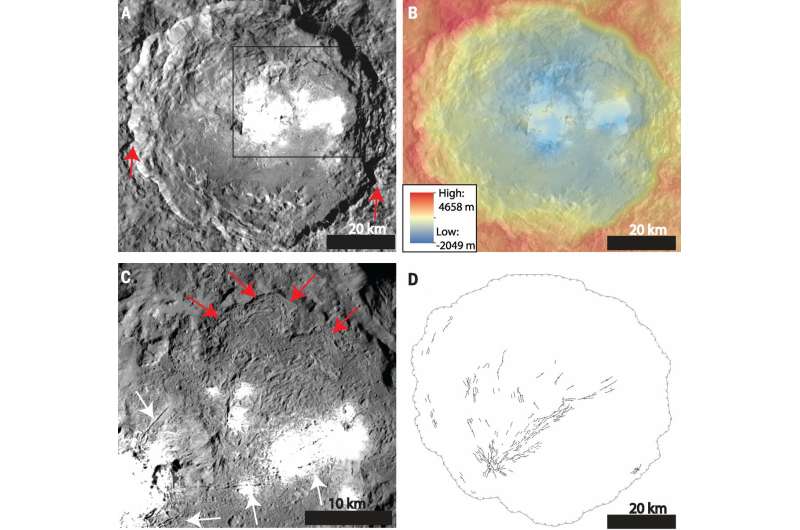Ice not a major factor of dwarf planet Ceres' surface features

Although there is significant evidence of ice on the surface of the dwarf planet Ceres, the largest object in orbit between Mars and Jupiter, an analysis of the surface geology indicates that ice is not a major factor in forming surface features, according to a paper in the September issue of Science magazine.
The paper is based on images obtained by NASA's Dawn spacecraft, which entered orbit around Ceres in March 2015 after completing its mission on the asteroid Vesta. Since that time, Dawn's instruments have created digital terrain models, three-dimensional visualizations of the surface of Ceres.
The resulting mapping allowed for a more detailed observation of Ceres' topography, which includes impact craters, linear structures, domical features and lobate flows. Craters appear to dominate Ceres, many of which have sharp walls and deep floors, although one topographically high region—a plateau named Hanami Planum—stood out to researchers. Researchers also spotted multiple mysterious bright spots in Ceres' craters.
Angular polygonal craters on the surface suggest that Ceres' crust is fractured, furthering the conclusion that the near-surface crust "must be both brittle enough to fracture and strong enough to retain fractures for long periods of time."
"Based on our analysis, the crust of Ceres is too strong to be dominated by ice," said Debra Buczkowski of the Johns Hopkins Applied Physics Laboratory in Laurel, Maryland, the study's lead author. "While surface features such as the lobate flows show that water ice is present in the dwarf planet's upper crust and on the surface in some locations, it appears not to be a major factor in creating surface features."
In addition to studying the surface, researchers drew conclusions about the dwarf planet's interior makeup. Beneath a strong crust composed of rock, ice and salt hydrates lays a water-rich mantle and a silicate core. Evidence of cryomagmatism is found in the floor-fractured craters, while Ahuna Mons and other domical features have been shown to be cryovolcanic in nature. These surface features suggest that Ceres has been geologically active at some point in its past, perhaps even its recent past.
This in-depth study was the first of its kind for Ceres. The primary purpose of the study was to answer questions about the dwarf planet; although some were answered, many more still remain.
Buczkowski is also a coauthor of three other papers about the dwarf planet appearing in this month's issue of Science magazine.
More information: "The geomorphology of Ceres," by D.L. Buczkowski et al. science.sciencemag.org/cgi/doi … 1126/science.aaf4332
Journal information: Science
Provided by Johns Hopkins University





















